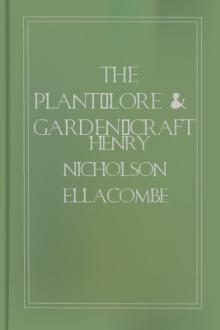The plant-lore & garden-craft of Shakespear, Henry Nicholson Ellacombe [read with me .TXT] 📗

- Author: Henry Nicholson Ellacombe
- Performer: -
Book online «The plant-lore & garden-craft of Shakespear, Henry Nicholson Ellacombe [read with me .TXT] 📗». Author Henry Nicholson Ellacombe
With this pretty picture I may well close the account of the Crocus, but not because the subject is exhausted, for it is very tempting to go much further, and to speak of the beauties of the many species, and of the endless forms and colours of the grand Dutch varieties; and whatever admiration may be expressed for the common yellow Dutch Crocus, the same I would also give to almost every member of this lovely and cheerful family.
FOOTNOTES:[268:1] Fuller says of the crocodile—"He hath his name of χροχό-δειλος, or the Saffron-fearer, knowing himself to be all poison, and it all antidote."—Worthies of England, i, 336, ed. 1811.
[270:1] "Cilician," or "Corycean," were the established classical epithets to use when speaking of the Saffron. Cowley quotes—
and adds the note—"Omnes Poetæ hoc quasi solenni quodam Epitheto utuntur. Corycus nomen urbis et montis in Cilicia, ubi laudatissimus Crocus nascebatur."—Plantarum, lib. i, 49.
[270:2] "Saffron is . . . a native of Cashmere, . . . and the . . . Saffron Crocus and the Hemp plant have followed their (the Aryans) migrations together throughout the temperate zone of the globe."—Birdwood, Handbook to the Indian Court, p. 23.
[271:1] "Our English hony and Safron is better than any that commeth from any strange or foregn land."—Bullein, Government of Health, 1588.
[271:2] The arms of the borough of Saffron Walden are "three Saffron flowers walled in."
SAMPHIRE. Edgar. Half-way downHangs one that gathers Samphire, dreadful trade!
Methinks he seems no bigger than his head. King Lear, act iv, sc. 6 (14).
Being found only on rocks, the Samphire was naturally associated with St. Peter, and so it was called in Italian Herba di San Pietro, in English Sampire and Rock Sampier[274:1]—in other words, Samphire is simply a corruption of Saint Peter. The plant grows round all the coasts of Great Britain and Ireland, wherever there are suitable rocks on which it can grow, and on all the coasts of Europe, except the northern coasts; and it is a plant very easily recognized, if not by its pale-green, fleshy leaves, yet certainly by its taste, or its "smell delightful and pleasant." The leaves form the pickle, "the pleasantest sauce, most familiar, and best agreeing with man's body," but now much out of fashion. In Shakespeare's time the gathering of Samphire was a regular trade, and Steevens quotes from Smith's "History of Waterford" to show the danger attending the trade: "It is terrible to see how people gather it, hanging by a rope several fathoms from the top of the impending rocks, as it were in the air." In our own time the quantity required could be easily got without much danger, for it grows in places perfectly accessible in sufficient quantity for the present requirements, for in some parts it grows away from the cliffs, so that "the fields about Porth Gwylan, in Carnarvonshire, are covered with it." It may even be grown in the garden, especially in gardens near the sea, and makes a pretty plant for rockwork.
There is a story connected with the Samphire which shows how botanical knowledge, like all other knowledge, may be of great service, even where least expected. Many years ago a ship was wrecked on the Sussex coast, and a small party were left on a rock not far from land. To their horror they found the sea rising higher and higher, and threatening before long to cover their place of refuge. Some of them proposed to try and swim for land, and would have done so, but just as they were preparing for it an officer saw a plant of Samphire growing on the rock, and told them they might stay and trust to that little plant that the sea would rise no further, for that the Samphire, though always growing within the spray of the sea, never grows where the sea could actually touch it. They believed him and were saved.
FOOTNOTES:[274:1] Dr. Prior.
SAVORY. Perdita. Here's flowers for you;Hot Lavender, Mints, Savory, Marjoram. Winter's Tale, act iv, sc. 4. (103).
Savory might be supposed to get its name as being a plant of special savour, but the name comes from its Latin name Saturcia, through the Italian Savoreggia. It is a native of the South of Europe, probably introduced into England by the Romans, for it is mentioned in the Anglo-Saxon recipes under the imported name of Savorie. It was a very favourite plant in the old herb gardens, and both kinds, the Winter and Summer Savory, were reckoned "among the farsing or farseting herbes, as they call them" (Parkinson), i.e., herbs used for stuffing.[275:1] Both kinds are still grown in herb gardens, but are very little used.
FOOTNOTES:[275:1]
And pynnes, for to give fair wyves."
Canterbury Tale, Prologue.
Henry V, act iv, sc. 1 (431).
The word still exists as "forced;" e.g., "a forced leg of mutton," "forced meat balls."
SEDGE. (1) 2nd Servant. And Cytherea all in Sedges hid,Which seem to move and wanton with her breath,
Even as the waving Sedges play with wind. Taming of the Shrew, Induction, sc. 2. (53). (2) Iris. You nymphs, called Naiads, of the winding brooks,
With your Sedged crowns and ever-harmless looks. Tempest, act iv, sc. 1 (128). (3) Julia. The current that with gentle murmur glides,
Thou knowest, being stopped, impatiently doth rage;
But when his fair course is not hindered,
He makes sweet music with the enamell'd stones,
Giving a gentle kiss to every Sedge
He overtaketh in his pilgrimage;
And so by many winding nooks he strays
With willing sport to the wild ocean. Two Gentlemen of Verona, act ii, sc. 7 (25). (4) Benedick. Alas, poor hurt fowl! now will he creep into Sedges. Much Ado About Nothing, act ii, sc. 1 (209). (5) Hotspur. The gentle Severn's Sedgy bank. 1st Henry IV, act i, sc. 3 (98). (6) See Reeds, No. 7.
Sedge is from the Anglo-Saxon Secg, and meant almost any waterside plant. Thus we read of the Moor Secg, and the Red Secg, and the Sea Holly (Eryngium maritimum) is called the Holly Sedge. And so it was doubtless used by Shakespeare. In our day Sedge is confined to the genus Carex, a family growing in almost all parts of the world, and containing about 1000 species, of which we have fifty-eight in Great Britain; they are most graceful ornaments both of our brooks and ditches; and some of them will make handsome garden plants. One very handsome species—perhaps the handsomest—is C. pendula, with long tassel-like flower-spikes hanging down in a very beautiful form, which is not uncommon as a wild plant, and can easily be grown in the garden, and the flower-spikes will be found very handsome additions to tall nosegays. There is another North American species, C. Fraseri, which is a good plant for the north side of a rock-work: it is a small plant, but the flower is a spike of the purest white, and is very curious, and unlike any other flower.
SENNA. Macbeth. What Rhubarb, Senna, or what purgative drugWould scour these English hence?[277:1] Macbeth, act v, sc. 3 (55).
Even in the time of Shakespeare several attempts were made to grow the Senna in England, but without success; so that he probably only knew it as an important "purgative drug." The Senna of commerce is made from the leaves of Cassia lanceolata and Cassia Senna, both natives of Africa, and so unfitted for open-air cultivation in England. The Cassias are a large family, mostly with handsome yellow flowers, some of which are very ornamental greenhouse plants; and one from North America, Cassia Marylandica, may be considered hardy in the South of England.
FOOTNOTES:[277:1] In this passage the old reading for "Senna" is "Cyme," and this is the reading of the Globe Shakespeare; but I quote the passage with "Senna" because it is so printed in many editions.
SPEARGRASS. Peto. He persuaded us to do the like. Bardolph. Yea, and to tickle our noses with Speargrass to make them bleed, and then to beslubber our garments with it and swear it was the blood of true men. 1st Henry IV, act ii, sc. 4 (339).Except in this passage I can only find Speargrass mentioned in Lupton's "Notable Things," and there without any description, only as part of a medical recipe: "Whosoever is tormented with sciatica or the hip gout, let them take an herb called Speargrass, and stamp it and lay a little thereof upon the grief." The plant is not mentioned by Lyte, Gerard, Parkinson, or the other old herbalists, and so it is somewhat of a puzzle. Steevens quotes from an old play, "Victories of Henry the Fifth": "Every day I went into the field, I would take a straw and thrust it into my nose, and make my nose bleed;" but a straw was never called Speargrass. Asparagus was called Speerage, and the young shoots might have been used for the purpose, but I have never heard of such a use; Ranunculus flammula was called Spearwort, from its lanceolate leaves, and so (according to Cockayne) was Carex acuta, still called Spiesgrass in German. Mr. Beisly suggests the Yarrow or Millfoil; and we know from several authorities (Lyte, Hollybush, Gerard, Phillip, Cole, Skinner, and Lindley) that the Yarrow was called Nosebleed; but there seems no reason to suppose that it was ever called Speargrass, or could have been called a Grass at all, though the term Grass was often used in the most general way. Dr. Prior suggests the Common Reed, which is probable. I have been rather inclined to suppose it to be one of the Horse-tails (Equiseta).[278:1] They are very sharp and spearlike, and their rough surfaces would soon draw blood; and as a decoction of Horse-tail was a remedy for stopping bleeding of the nose, I have thought it very probable that such a supposed virtue could only have arisen when remedies were sought for on the principle of "similia similibus curantur;" so that a plant, which in one form produced nose-bleeding, would, when otherwise administered, be the natural remedy.





Comments (0)